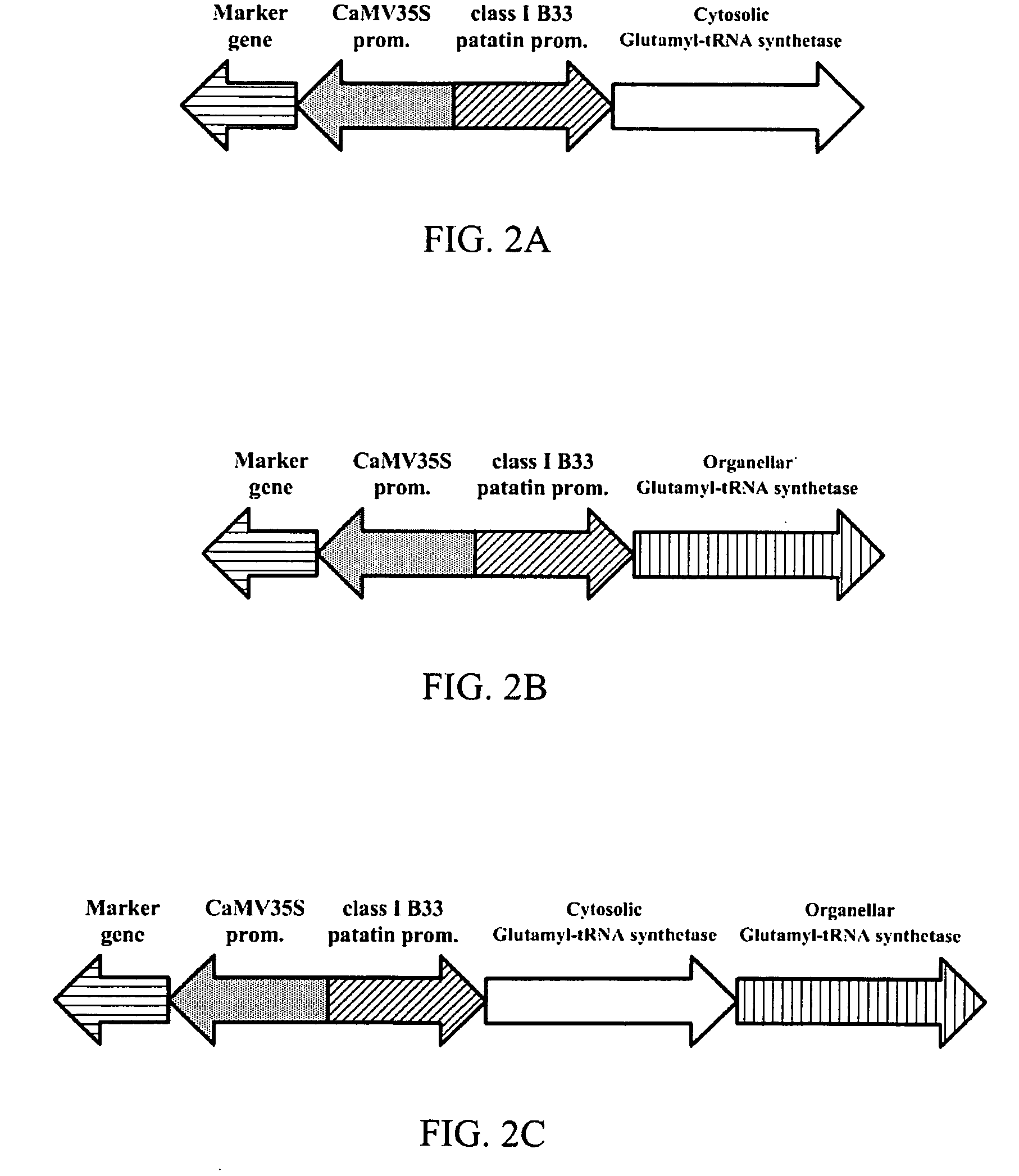Transgenic plant expressing glutamyl-tRNA synthetase
- Summary
- Abstract
- Description
- Claims
- Application Information
AI Technical Summary
Benefits of technology
Problems solved by technology
Method used
Image
Examples
example 1
Establishment of DNA Constructs
[0031]A 2760 bp DNA fragment (SEQ ID NO:1) that encoded the cytosolic Glutamyl-tRNA synthetase (SEQ ID NO:2) of Arabidopsis thaliana and a 2055 bp DNA fragment (SEQ ID NO:3) that encoded the organellar Glutamyl-tRNA synthetase (SEQ ID NO:4) of Arabidopsis thaliana were isolated respectively. Please refer to FIG. 1 and FIG. 2 for some examples of DNA constructs established herein. DNA constructs contain each of the DNA fragments or both of the DNA fragments were established respectively. The DNA constructs further contain specific promoter(s), such as CaMV35S promoter, glutelin 1 promoter, and class I B33 patatin promoter. Moreover, the DNA constructs can contain a marker gene, such as a phosphomannose isomerase gene. The DNA constructs were individually delivered into the rice or potato genome via Agrobacterium-mediated transformation as described in Example 2 and Example 3, respectively.
example 2
Rice Transformation
[0032]Germination: Sterilize rice seeds with 30% bleach solution, then wash with autoclaved water and spread the sterilized rice seeds onto MS medium (MS+vitamin basal medium, 30 g / L sucrose, 0.7% agar, pH5.8) plate. Grow them in the dark, at 30° C. for 3-5 days.
[0033]Induction of Callus: Transfer germinated rice seeds to CIM plates (N6+vitamin basal medium, 0.3 g / L casamino acid, 2.8 g / L raline, 2 mg / L 2,4-D, 100 mg / L myo-inositol, 30 g / L sucrose, 0.7% agar, pH 5.7), and perform callus induction, and then incubate at 30° C. with continuous illumination; subculture them every two weeks.
[0034]Infection: Infect subcultured callus cells after 1 week with Agrobacterium suspension cells containing the DNA construct. Agrobacterium suspension cells can be diluted to OD600nm=0.6-0.8 with AAM medium solution (440 mg / L CaCl22H2O, 370 mg / L MgSO47H2O, 170 mg / L KH2PO4, 37.5 mg / L Fe-EDTA, 6.2 mg / L H3BO3, 22.3 mg / L MnSO44H2O, 8.6 mg / L ZnSO47H2O, 0.83 mg / L KI, 0.25 mg / L Na2MoO42H...
example 3
Potato Transformation
[0039]Sterile seedlings: Sterilize potato tubers with 30% bleach, then wash with autoclaved water, and incubate them onto MS medium plates for germination.
[0040]Preculture: Use young leaves of sterile seedlings for preculture. Cut young leaves into segments with 5 mm width, transfer them with upper surface of leaves down to medium HH plates (MS+vitamin basal medium, 3% sucrose, 10 mg / L NAA, 10 mg / L Zeatin riboside, 0.7% agar, pH 5.6-5.8) for preculture and then incubate at 20-22° C. with photoperiod 16 hr light / 8 hr dark and light intensity 60 μE / m2s.
[0041]Infection: Dilute agrobacterium cells to OD600nm=0.6-0.8 with COD medium (MS+vitamin basal medium, 3% sucrose, 200 μM acetosyringone). Incubate with precultured leave segments for 10 min.
[0042]Co-culture: Transfer leaf segments with upper surface down to medium LSR1 plates (containing 200 μM acetosyringone, MS+vitamin basal medium, 3% sucrose, 0.2 mg / L NAA, 2 mg / L Zeatin riboside, 0.02 mg / L GA3, 0.7% agar, pH ...
PUM
 Login to View More
Login to View More Abstract
Description
Claims
Application Information
 Login to View More
Login to View More - R&D
- Intellectual Property
- Life Sciences
- Materials
- Tech Scout
- Unparalleled Data Quality
- Higher Quality Content
- 60% Fewer Hallucinations
Browse by: Latest US Patents, China's latest patents, Technical Efficacy Thesaurus, Application Domain, Technology Topic, Popular Technical Reports.
© 2025 PatSnap. All rights reserved.Legal|Privacy policy|Modern Slavery Act Transparency Statement|Sitemap|About US| Contact US: help@patsnap.com


